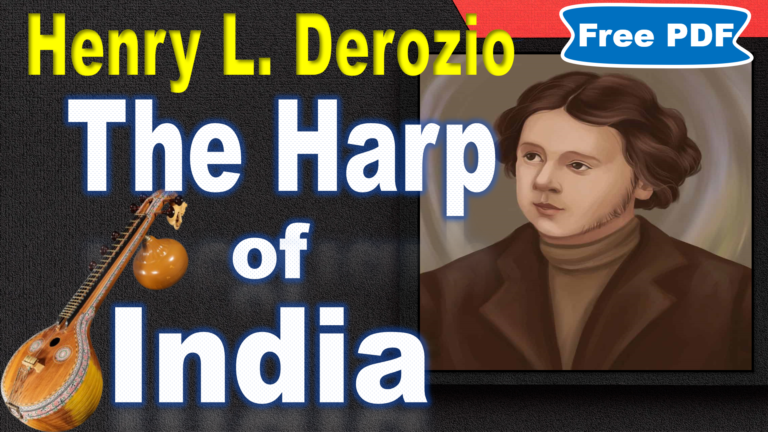India Poem by Shoshee Chunder Dutt Summary
The poem begins with the poet contemplating the future, acknowledging that it’s a mystery known only to God. Despite this, he asserts that dreaming about the future is not a sin. He then shares his dream for India, his motherland.
In his dream, he sees a free and enlightened India. The phrase “Freedom’s pure shrine” symbolizes a nation where liberty is revered, and the “morning light” represents a new dawn of freedom and hope. He sees the sorrows of the past, represented by “tear-drops”, disappearing, indicating an end to suffering and oppression. The land is free from sighs and groans, further emphasizing the end of hardship.
The poet also envisions progress and development in India, symbolized by the resurgence of science. The “patriot valour” watching over the “smiling strand” represents the courage and determination of the people vigilantly protecting their land.
The poem concludes with the poet questioning why this vision of a free and prosperous India should remain just a dream. He expresses a deep longing for the freedom of India, the “land of my fathers”. This reflects his patriotic spirit and his profound love for his country.
Overall, the poem is a fervent wish for India’s freedom and progress. It’s a powerful call for liberation, progress, and the end of suffering. The poet uses vivid imagery and emotive language to convey his dream of a free and prosperous India. It’s a testament to his patriotic spirit and his deep love for his country.
Key Points
Author
The author of the poem is Shoshee Chunder Dutt, an Indian writer known for his English prose and poetry. He was one of the first Indian authors to write in English and made significant contributions to Indian literature.
Form (Rhyme Scheme)
The poem is a sonnet, a form of poetry traditionally known for its structure and rhyme scheme. It appears to follow the structure of an English or Shakespearean sonnet, which is usually divided into three quatrains (four-line stanzas) and a final couplet (two-line stanza). The rhyme scheme of the poem seems to be ABAB CDCD EFEF GG.
Speaker
The speaker of the poem is the poet himself, Shoshee Chunder Dutt. He speaks from a personal perspective, expressing his dreams and hopes for his motherland, India.
Setting
The setting of the poem is not explicitly stated, but it can be inferred that the poem is set in India, the poet’s motherland. The poem reflects the socio-political context of the time, expressing the poet’s longing for freedom and progress in India.
Theme
The main theme of the poem is the longing for freedom and progress. The poet dreams of a future where India is free from oppression and suffering, and where science and knowledge flourish. The poem also explores themes of patriotism, hope, and the power of dreams.
Plot
The poem does not have a traditional plot as it is not a narrative poem. Instead, it presents the poet’s dream of a free and prosperous India. The poet contemplates the future, shares his dream, and expresses his longing for this dream to become reality.
Tone
The tone of the poem is hopeful and passionate. The poet expresses a deep love for his country and a fervent wish for its freedom and prosperity. His words convey a sense of anticipation and longing for a brighter future.
Style
The poem is characterized by its lyrical style and use of poetic devices such as metaphor, personification, and symbolism. The poet uses vivid imagery and emotive language to convey his dream of a free and prosperous India.
Message
The message of the poem is a call for liberation, progress, and the end of suffering. The poet urges the reader to strive for freedom and progress, not just for oneself, but for the entire nation. It’s a powerful expression of the poet’s vision for his country, filled with hope, dreams, and a longing for freedom. It’s a testament to the power of dreams and the importance of hope in shaping the future. It’s a reflection of the poet’s deep love for his country and his desire to see it flourish and prosper.
Structure and Rhyme Scheme
The poem “India” by Shoshee Chunder Dutt is a sonnet, a form of poetry traditionally known for its structure and rhyme scheme.
Structure: The poem consists of 14 lines, which is typical of a sonnet. It appears to follow the structure of an English or Shakespearean sonnet, which is usually divided into three quatrains (four-line stanzas) and a final couplet (two-line stanza).
Rhyme Scheme: The rhyme scheme of the poem seems to be ABAB CDCD EFEF GG, which is characteristic of an English or Shakespearean sonnet. This means that the end words of the first and third lines of each quatrain rhyme with each other (A and A, C and C, E and E), as do the end words of the second and fourth lines (B and B, D and D, F and F). The final two lines (GG) form a rhymed couplet.
This structure and rhyme scheme contribute to the rhythm and flow of the poem, enhancing its lyrical quality and emotional impact. They also provide a framework within which the poet explores his themes and expresses his thoughts and feelings.
Shoshee Chunder Dutt
1. Birth and Death: Shoshee Chunder Dutt was born in 1824 and passed away in 1885. His life spanned a significant period of Indian history, including the era of British colonial rule.
2. Profession: Shoshee Chunder Dutt was a multifaceted personality. He was a Bengali author, historian, and poet. His diverse interests and talents are reflected in his wide range of works, which include historical accounts, poetry, and essays.
3. Pseudonyms: Like many authors, Shoshee Chunder Dutt also wrote under pseudonyms. He used the names J.A.G. Barton and Horatio Bickerstaffe Rowney for some of his works. This was a common practice among writers of his time, often used to explore different genres or themes.
4. Family: Shoshee Chunder Dutt was the uncle of Romesh Chunder Dutt, a renowned Indian civil servant, economic historian, and translator of Ramayana and Mahabharata. This suggests that the literary and intellectual pursuits ran in the family.
5. Works: Shoshee Chunder Dutt was a prolific writer. His works covered a wide range of topics, from historical accounts of India to explorations of nature and philosophical musings. His writings reflect his deep love for his country, his keen observation of the world around him, and his insightful understanding of various subjects. Shoshee Chunder Dutt wrote several works, including “The Works of Shoshee Chunder Dutt”, “Half-hours with Nature; or, Explorations for the Truth”, “The Ancient World”, “Bengal: An Account of the Country from the Earliest Times”, “The Great Wars of India”, “The Wild Tribes of India”, “Taxation in India”, “The Indian Statute Book”, “British Opium Policy, and its Results”, “A Vision of Sumeru, and other Poems”, “Reminiscences of a Keráni’s Life”, “The Young Zemindár”, “Stray Leaves — Essays, Poems and Tales”, “Bengaliana: A Dish of Rice and Curry, and Other Indigestible Ingredients”, and “Historical Studies and Recreations” among others.
6. Contribution to Literature: Shoshee Chunder Dutt’s contribution to Indian literature is significant. As one of the first Indian authors to write in English, he played a crucial role in shaping Indian English literature. His works often reflect his deep love for his country and his desire to see it prosper. They provide valuable insights into the socio-political context of his time and continue to be relevant today.
Word Meaning
| Tough Word | Meaning in English | Meaning in Hindi |
| Gaze | To look steadily and intently at something or someone | ताकना |
| Presumes | To suppose or assume something to be the case without proof | मान लेना |
| Mystic | Relating to mysteries or esoteric spiritual knowledge | रहस्यमय |
| Scan | To examine or look at something closely and carefully | स्कैन करना |
| Mighty | Having great power, strength, or influence | बलशाली |
| Sin | An immoral act considered to be a transgression against divine law | पाप |
| Dreamt | Past tense of dream, meaning to experience a series of images and emotions during sleep | सपना देखना |
| Wild delight | A strong feeling of pleasure or joy that is unrestrained or uninhibited | अजब आनंद |
| Shrine | A place regarded as holy because of its associations with a divinity or a sacred person or relic | मंदिर |
| Illumed | To illuminate or light up | प्रकाशित करना |
| Sighs | Audible exhalation expressing sadness, relief, or tiredness | सांस लेना |
| Groans | A deep, mournful sound expressing pain or disapproval | कराहट |
| Fled | Past tense of flee, meaning to run away from a place or situation of danger | भाग जाना |
| Aspired | To direct one’s hopes or ambitions toward achieving something | आकांक्षा रखना |
| Patriot valour | Courage and bravery displayed in service to one’s country | देशभक्ति और वीरता |
| Strand | A shore or beach, especially a sandy one | किनारा |
| Canst | Archaic form of “can” | |
| Thou | Archaic second-person singular pronoun, equivalent to “you” | तुम |
| Ne’er | Archaic contraction of “never” | कभी नहीं |










